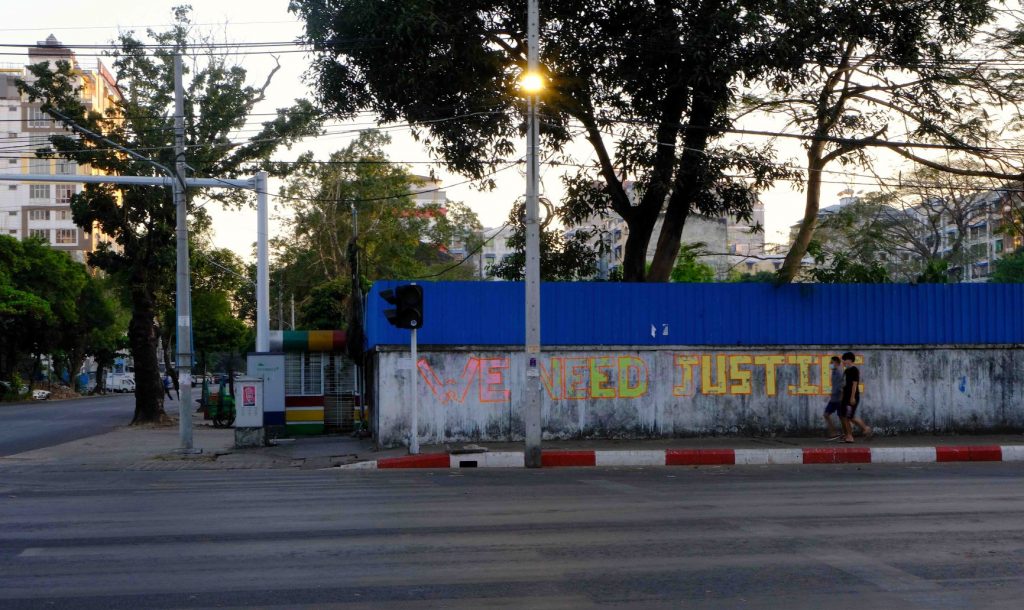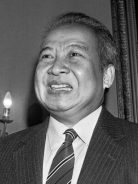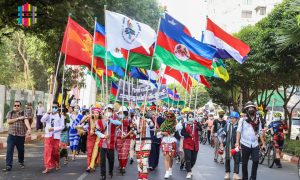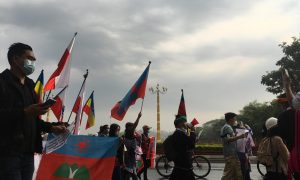Calls for Responsibility to Protect (R2P) have become a mainstay of the demonstrations in Myanmar. Such calls were also made earlier in the aftermath of the Cyclone Nargis disaster in 2008 and the Rakhine State riots in 2012. In these instances, the international community called for R2P in Myanmar, but this time it is the people of Myanmar who demand protection. Will they achieve their goal?
We need R2P in Myanmar
We need R2P in Myanmar
We need R2P in Myanmar#R2PforMyanmar #R2PforMyanmar #R2PforMyanmar pic.twitter.com/m4oAyZR71O— AungMyint Than (@than_aungmyint) March 30, 2021
The international community’s failure to act in Rwanda in the 1990s led to the consideration of how international society should have prevented the humanitarian crisis. The International Commission on Intervention and State Sovereignty (ICISS) presented The Responsibility to Protect report in December 2001, which defined the concept of R2P and generated an intense debate worldwide.
The 2005 World Summit Outcome Document (WSOD) adopted the concept of R2P with strict limitations on the scope of responsibility to protect against genocide, war crimes, ethnic cleansing, and crimes against humanity. In the following years, the UN also released a number of reports involving R2P, such as Implementing the Responsibility to Protect, Early Warning Assessment and the Responsibility to Protect, and The Role of Regional and Sub-regional Arrangement in Implementing the Responsibility to Protect.
These documents and reports dictate that states have a primary responsibility to protect their citizens, but the international community bears a responsibility to intervene when the target state is unwilling or unable to do so. R2P in practice refers mainly to military intervention, whether this is sending a peacekeeping force or the forces of a particular state or military alliance. Its introduction was intended as an alternative to the principle of non-intervention and non-use of force. However, the R2P is not a legal instrument, and it can also hardly be marked as a norm so far. In other words, it is merely a concept, and it remains the responsibility of the United Nations Security Council (UNSC) to determine whether armed intervention should be authorized.
The first difficulty facing a military intervention in Myanmar based on the R2P concept is the resolution process. Given R2P has no agreed triggering criteria, the adoption of R2P is discussed on a case-by-case basis. Although most states welcomed the idea of R2P, the exact timing of the protection is controversial.
Despite calls for intervention from various coalitions and individuals to date, no draft resolution for R2P intervention in Myanmar has materialised. Even if a state presents a draft resolution to the UNSC, reaching an agreement on Myanmar will not be easy. After all, the discussion on the Syrian case is nearly a decade old and has yet to reach a consensus. On top of that, the UNSC members are already divided on their interests.
This is evident from the fact that the 31 March UNSC session ended inconclusively with no sign of any agreement on what specific action the council would take. A divergence of views emerged from this meeting, where the British Ambassador to the UN stated that, “All measures are at our disposal”, while the Chinese Ambassador advocated to “step up diplomatic efforts and encourage the parties to narrow differences so as to find a way out”.
Considering Article 2 (7) of the UN Charter enshrines the norm of non-intervention, the application of R2P for military intervention requires, in principle, the consent of the targeted government. In the case of Darfur in Sudan, the UNSC used the R2P in 2006 for the first time. With due consent of the Sudanese government the Security Council adopted Resolution 1769 for presenting a joint UN-AU peacekeeping force. Given the fact that there is no anarchic or multi-government situation in Myanmar, the junta is much less likely to welcome outside armed intervention because they would themselves be the target of armed forces.
ASEAN has precedent and success in interceding in struggles for diplomatic recognition at the United Nations during the Third Indochina War (1978-1991).
ASEAN on Myanmar’s coup: revisiting Cold War diplomacy on Cambodia
What do the people in Myanmar want to achieve through R2P? Needless to say, pro-democracy protesters in the country aim to overthrow the military government and return to democratic government. Unfortunately, they are bound to be deeply disappointed because this does not fall under the scope of R2P, which only applies to genocide, war crimes, ethnic cleansing, and crimes against humanity.
On the other hand, the death toll among demonstrators had reached 543 as of April 1, and the actual number could be higher. Meanwhile, Thomas Andrews, the UN Special Rapporteur on the situation of human rights in Myanmar, stressed that the acts of the junta are likely to meet the legal threshold for crimes against humanity. Likewise, Kevin Rudd, former Australian prime minister, was more direct in saying that Myanmar is currently a “textbook case for R2P”.
Regardless of the feasibility of conducting an investigation, assuming an UNSC-authorized one is conducted, and the Burmese military is found to have committed crimes against humanity, could this translate into the adoption of interventions under R2P? The failure of previous attempts to move towards R2P in Syria, and it’s misapplication in Libya is evidence of the great difficulties in effective implementation.
Once the R2P is formally discussed in the UNSC, it is likely that the Burmese warlords could publicly promise to stop using weapons against the demonstrators or alter its repression approach. Then, this situation would leave the UNSC in the middle of an endless investigation and delay the adoption of a resolution on military intervention.
Even if there would be a draft mandate to end the Myanmar junta’s crimes against humanity, China and Russia would surely be concerned that military intervention would be steered in a non-mandated direction, given the precedent set in Libya, when intervention from the US, UK, and France continued after regime change. As veto holders, they can therefore prevent the resolution from being passed.
R2P is not a panacea. In fact, the capacity of R2P is limited, and the decision-making process is fraught with political gamesmanship. With all these factors in play, the Myanmar people’s call for the R2P to help them end this crisis is arguably unlikely to translate into action.
 Facebook
Facebook  Twitter
Twitter  Soundcloud
Soundcloud  Youtube
Youtube  Rss
Rss 



